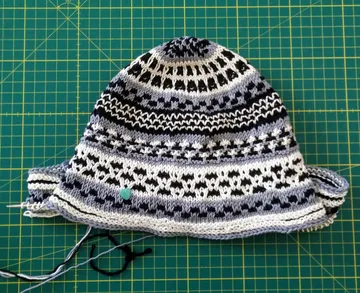I lied / Böse gelogen
Letzten Montag schrieb ich: "Die nächsten Projekte sind definitiv einfarbig oder kommen aus einem Knäuel." Das war eine freche Lüge. Ich vergaß, dass ich noch eine Mütze für eine meiner Schwestern stricken muss, weil diejenige, die ich ihr gemacht habe, mir passt - aber nicht ihr. Ich hatte nicht erwartet, dass sie einen solchen Dickkopf hat...
Last Monday I wrote "The next projects are definitely single colored or single skein." That was a bold lie. I forgot I still have to knit a hat for one of my sisters because the one I made fit me - but not her. I hadn't expected her to have such a big head ;)

Die fertige Mütze auf der neuen - das grüne Herzchen zeigt wie weit ich bin. Das Muster sieht komplizierter aus als es ist - das sind alles Hebemaschen, man strickt also nur mit einer Farbe pro Reihe. Hatte ich erwäht dass ich es hasse mit reiner Baumwolle zu stricken?
The finished hat on top of the one in progress - the little green heart shows how far I am with knitting the second. The pattern isn't as complicated as it seems to be - it's mosaic knitting with slipped stithes, you only use one color per row. Did I mention that I hate to knit with pure cotton?
Socks toe-up / Socken von unten
Ich stricke meine Socken am liebsten "von unten", also an den Zehen beginnend. Das ist nicht so viel anders als von oben, aber ich will einmal erklären was man beachten muss und was es für Möglichkeiten gibt. Damit das nicht zu lang wird, gibt es zwei Teile - die andere Hälfte kommt nächste Woche.
I prefer to knit my socks "from the bottom", i.e. starting at the toes. That's not so much different than knitting them cuff-down, but I want to explain what you have to consider and what possibilities there are. I don't want the post to be too long, so I'l divide it in two parts with the second coming next week.
Dieses Tutorial ist nicht für Socken-Neulinge gemacht. Ein, zwei Paar sollte man schon gestrickt haben. Und da man das Rad nicht neu erfinden muss, habe ich einige gute Videos verlinkt - da wird alles viel schöner gezeigt und erklärt als ich es könnte :)
This tutorial is not made for sock novices. One or two pairs should have been knitted already. And since you don't have to reinvent the wheel, I've linked some good videos - everything is shown and explained much more clearly than I might have been able to.
Needles / Nadeln
Man kann diejenigen Nadeln verwenden, mit denen man am besten vertraut ist: entweder ein Nadelspiel, zwei Rundnadeln oder eine Rundnadel in der Magic Loop Technik. Ich erkläre es für ein Nadelspiel.
You can use what you're most familiar with: either DPNs, two circular needles or one circular needle using the magic loop technique. My explanations are for DPNs.
Casting on / Maschen anschlagen
Ich kenne zwei Arten, wie man Maschen anschlägt für Toe-up Socken: "Judy's Magic Cast-On", hier erklärt.
I know two ways of Casting on: "Judy's Magic Cast-On", here shown by one of my favorite English-speaking knitting tutors, Staci Perry aka "Verypink Knits".
Der andere ist der "Türkische Anschlag" - obwohl ich nicht weiß, ob sie den in der Türkei wirklich nutzen ;) Das beste Video ist eines von Garnstudio(Drops) - normalerweise mag ich deren Videos nicht, weil sie ohne Ton sind und ich finde es ein wenig gruselig.
The other one is the "Turkish Cast-On" - though I don't know whether they really use that in Turkey ;) The best video is one by Garnstudio(Drops) - normally I don't like their videos because they are without any sound and I find it a bit creepy.
Das Ergebnis von beiden ist das gleiche: eine Reihe von Maschen auf der oder den Nadel(n). Einfach nun an die normale Weise halten wie die Zehe gestrickt werden und die Schritte umkehren: Maschen zu nehmen statt abnehmen. Wenn die normale Anzahl an Maschen erreicht ist, kann der Fuß der Socke gestrickt werden.
The result of both of them is the same: a number of stitches on your needle(s). Just think of your normal way to knit the toe and reverse the steps: increasing instead of decreasing. If you have the right number of stitches you can start knitting the foot of the sock.
The heel / Die Ferse
I have two different ways to form the heel: one with a heel-flap that closely resembles the "top-down heelflap" form and one formed only by short rows.
Heelflap toe-up / Käppchenferse von unten
Du strickst den Fuß der Socke bis etwa zum Ende des Spannes. Jetzt kommt der Zwickel, wo du zunehmen musst. Die Anzahl der zusätzlichen Maschen ist (beim Nadelspiel): die Anzahl der Maschen auf einer Nadel minus zwei.
You knit the foot of the sock till about the end of the instep and the start of the heel. Now comes the gusset where you have to increase. The number of additional numbers is (for DPNs): the number of stitches on one needle minus two.
Jetzt eine Masche stricken , eine Masche zunehmen (mit der bevorzugten Technik), einen Marker setzen, bis eine Masche vor dem Ende der nächsten Nadel stricken, einen Marker setzen, eine Masche zunehmen und die letzte Masche stricken. Zunahmen erfolgen in jeder zweiten Reihe vor Marker 1 und nach Marker 2.
Now knit one stitch, increase a stitch (using you favorite technique), set a marker, knit till one stitch before the end of the next needle, set a marker, increase a stitch, and knit the last stitch. Increases are done every second row before marker 1 and after marker 2.

Auf den Bild kann man den Zwickel und die Zunahmen dafür gut erkennen.
You can see the gusset and the increases I made on the photo.
| https://steemitimages.com/300x0/https://ipfs.busy.org/ipfs/QmecULsErxwJQyshpY6vQ1dAFFuVQBch9dZmZikSqPDmYY |  |  |
|---|---|---|
5% der Einnahmen dieses Posts gehen automatisch an @t-r-f, den Reisekostenunterstützungsfond für das SteemFest.
|